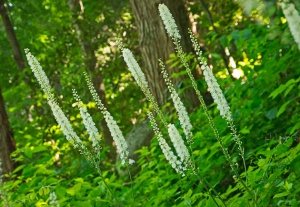Black Cohosh
See also : Cimicifuga (Homeopathy)
Other Names: Actaea macrotys, Actaea racemosa, Actée à Grappes, Actée à Grappes Noires, Actée Noire, Aristolochiaceae Noire, Baie d’actée, Black Cohosh, Baneberry, Black Aristolochiaceae, Black Snakeroot, Bugbane, Bugwort, Cimicaire à Grappes, Cimicifuga, Cimicifuga Racemosa, Cimicifuge, Cohosh Negro, Cohosh Noir, Cytise, Herbe aux Punaises, Macrotys, Phytoestrogen, Phytoestrogène, Racine de Serpent, Racine de Squaw, Racine Noire de Serpents, Rattle Root, Rattle Top, Rattlesnake Root, Rattleweed, Rhizoma Cimicifugae, Sheng Ma, Snakeroot, Squaw Root.
Black cohosh is an herb. The root of this herb is used for medicinal purposes. Black cohosh was first used for medicinal purposes by Native American Indians, who introduced it to European colonists. Black cohosh became a popular treatment for women’s health issues in Europe in the mid-1950s.
Special Precautions of Black Cohosh
- The safety of black cohosh in pregnant or breastfeeding women or children hasn't been established. Black cohosh is sometimes used by nurse-midwives to induce labor, but it should never be used by a pregnant woman without supervision by a qualified healthcare provider because it could stimulate uterine contractions and result in miscarriage.
- People with hormone-sensitive conditions, such as cancer of the breast, prostate, ovaries or uterus, endometriosis or uterine fibroids, should avoid black cohosh until more is known about how it works and whether it has a hormonal effect.
- Side effects of black cohosh may include:
- Indigestion
- Headache
- Nausea
- Perspiration
- Vomiting
- Heaviness in the legs
- Weight gain
- Low blood pressure
- Excessive doses of black cohosh may cause seizures, visual disturbances and slow or irregular heartbeat. There have been a number of cases of liver damage suspected to be associated with black cohosh use. In most of the cases, there were other medical problems present and other medications used that may have contributed to the liver damage. Also, the quality and purity of the black cohosh products used isn't known. Some black cohosh products, for instance, have been found to contain a Chinese cimicifuga (Cimicifuga foetida) instead of black cohosh.
- Still, in August 2006, Health Canada advised consumers of the possible link between black cohosh and liver damage. In June 2007, the United States Pharmacopeia proposed that black cohosh product labels contain a cautionary statement. The American Botanical Council has countered that there is insufficient evidence to warrant the proposed caution.
- Black cohosh should not be confused with the herb blue cohosh (Caulophyllum thalictroides), white cohosh, bugbane, Cimicifuga foetida, sheng ma or white baneberry. These species have different effects, and blue cohosh and white cohosh, in particular, can be toxic. There is a case report of neurological complications in a post-term baby after labor induction with a herbal blend of black cohosh and blue cohosh.
- People with allergies to plants in the buttercup (Ranunculaceae) family should avoid black cohosh.
- Black cohosh contains small amounts of salicylic acid, so people with allergies to aspirin or salicylates should avoid black cohosh.
- People with a history of blood clots or stroke, seizures, liver disease and those who are taking medications for high blood pressure should not use black cohosh.
- Possible Drug Interactions :Because it may act like the hormone estrogen in the body, black cohosh could interfere with hormone replacement therapy or oral contraceptives.Black cohosh may interfere with the effectiveness of the chemotherapy drug cisplatin.Theoretically, black cohosh may interfere with the effectiveness of hormone replacement therapy or oral contraceptives.
The benefits of Black Cohosh are
How black cohosh works isn't understood. It was once thought to have estrogen-like activity, but there is growing evidence that it does not. The parts of the plant used medicinally are the fresh or dried roots and rhizomes (underground stems), which are available in health food stores, some drug stores and online in tea, capsule, tablet or liquid extract forms. The active compound is believed to be 26-deoxyactein.
- Menopausal Symptoms : Black cohosh is one of the more popular herbal remedies for menopausal symptoms, such as hot flashes, night sweats, migraines, mood disturbances, heart palpitations and vaginal dryness
- Has been widely used in Eastern Europe to treat pulmonary, circulatory and nervous system problems.
- Research studies have shown that it is an effective herbal alternative in lowering blood pressure.
- Some herbalists in Russia even use this as a tonic drink for people who have problems with the central nervous system.
- for womens' health conditions, such as menstrual cramps and hot flashes, arthritis, muscle pain, sore throat, cough and indigestion.
- The juice of the plant was used as an insect repellent and was made into a salve and applied to snake bites.
